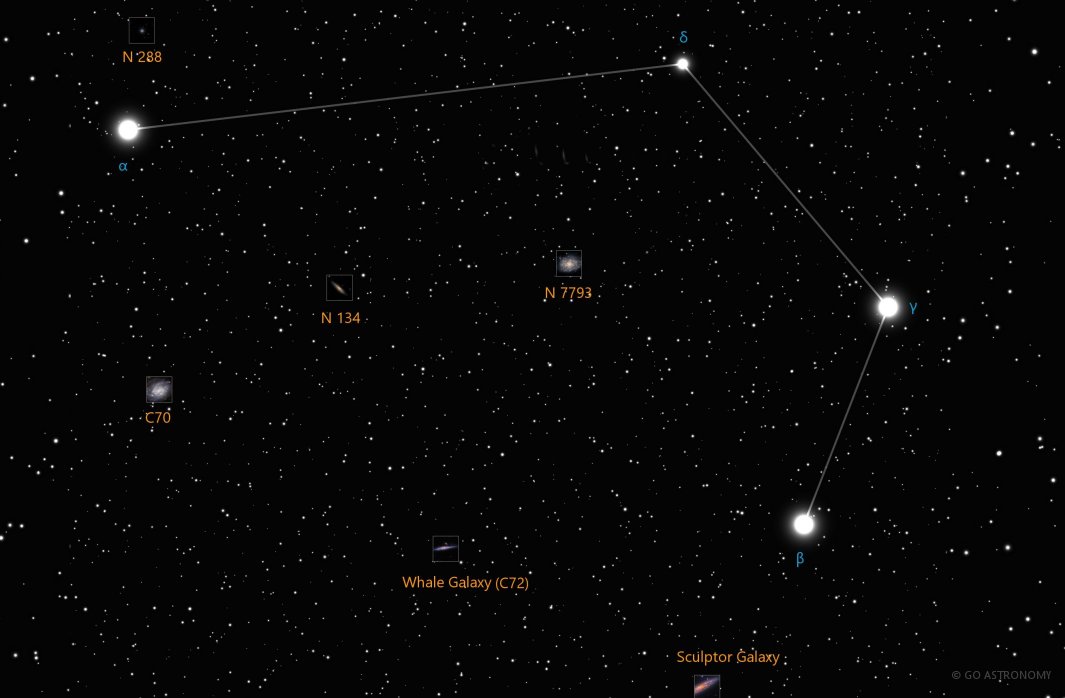Sculptor, the Sculptor (Scl)
(SCULP-ter)
The Southern constellation of Sculptor, the Sculptor, is best viewed in Fall during the month of November.
Sculptor is the 36th largest constellation. It's brightest star is Alpha Sculptoris at magnitude 4.30. The boundary of the Sculptor constellation contains 6 stars that host known exoplanets.
- Pronunciation:
- SCULP-ter
- Meaning:
- Sculptor
- Genitive:
- Sculptoris
- Abbreviation:
- Scl
- Constellation Family:
- LaCaille
- Hemisphere:
- Southern
- Quadrant:
- SQ1
- Visibility:
- 50° N - 90° S
- Best viewing month*:
- November
- Area:
- 475 sq. degrees
- Size:
- 36th largest
- Right Ascension (avg):
- 1h 0m
- Declination (avg):
- -31°
- Brightest star:
- Alpha Sculptoris (4.30)
- Stars with planets:
- 6
- Messier objects:
- |
Brightest Stars in Sculptor
The 10 brightest stars in the constellation Sculptor by magnitude.
- Star
- Magnitude
- Spectral class
- Alpha Sculptoris (α Scl)
- 4.3
- B7IIIp
- Beta Sculptoris (β Scl)
- 4.38
- B9.5IVMNpe
- Gamma Sculptoris (γ Scl)
- 4.41
- K1III
- Delta Sculptoris (δ Scl)
- 4.59
- A0V
- Eta Sculptoris (η Scl)
- 4.86
- M2/M3III
- Zeta Sculptoris (ζ Scl)
- 5.04
- B4V
- Iota Sculptoris (ι Scl)
- 5.18
- K0III
- Theta Sculptoris (θ Scl)
- 5.24
- F3/F5V
- Pi Sculptoris (π Scl)
- 5.25
- K1II/III
- Epsilon Sculptoris (ε Scl)
- 5.29
- F2IV
- Mu Sculptoris (μ Scl)
- 5.3
- K0III
Star Clusters in Sculptor
The most notable and easy-to-find star clusters in the constellation Sculptor . Also see all star clusters.
Galaxies in Sculptor
The most notable galaxies in the constellation Sculptor . Also see all galaxies.
- Name
- Alt name
- Type
- Burbidge's Chain
- galaxy group
- Cartwheel Galaxy
- ring
- Comet Galaxy
- spiral
- Sculptor Dwarf Galaxy
- dwarf
- Sculptor Galaxy
- C65
- starburst
- Caldwell 70
- C70
- spiral
- Southern Cigar Galaxy
- C72
- spiral
Milky Way Satellites in Sculptor
Dwarf satellite galaxies that orbit the Milky Way Galaxy located in the constellation Sculptor. Also see all Milky Way satellite galaxies.
- Galaxy name
- Alt name
- Magnitude
- Sculptor Dwarf
- 10.4
The Artist's Easel in the Night Sky
The constellation Sculptor, known as 'The Sculptor,' sits relatively inconspicuously in the Southern Hemisphere's autumn sky. Despite its modest reputation, Sculptor is home to several intriguing deep-sky objects.
Historical Background
Sculptor is a relatively modern constellation. It was introduced by the French astronomer Nicolas Louis de Lacaille in the mid-18th century. Lacaille, while working in South Africa, charted the southern skies and introduced 14 new constellations, most of them named after scientific instruments and artists' tools. 'L'Atelier du Sculpteur' or 'the sculptor's studio' was one of them, which later was shortened to just 'Sculptor.'
Location and Visibility
Located between the constellations of Cetus and Phoenix, Sculptor lies in the southern sky's water section. This constellation is best viewed from the Southern Hemisphere during the spring months, but those in the Northern Hemisphere can spot it near the southern horizon in the autumn. Sculptor spans about 475 square degrees of the sky, ranking 36th in size among the 88 constellations.
Notable Stars in Sculptor
Although Sculptor contains no particularly bright stars, it's home to several notable ones. Its brightest star, Alpha Sculptoris, is a blue-white B-type giant approximately 780 light-years from Earth. The constellation's second-brightest star, Beta Sculptoris, is also a B-type giant, located around 170 light-years away. Gamma Sculptoris, a binary star system about 143 light-years from us, offers a fascinating target for amateur astronomers equipped with small telescopes.
Deep Sky Objects
Sculptor is rich in galaxies due to its location away from the plane of the Milky Way, where interstellar dust could obscure our view. The constellation hosts the Sculptor Galaxy (NGC 253), one of the brightest galaxies in the sky and a favorite amongst amateur astronomers. Other noteworthy galaxies include the Cartwheel Galaxy, an unusual lenticular galaxy and the Sculptor Dwarf, a spheroidal galaxy that's a satellite of our Milky Way.
Observation
As Sculptor is a dim constellation, it's best observed from a dark site away from city lights. Observers in the Southern Hemisphere can view it high in the sky during the spring months. In contrast, those in the Northern Hemisphere should look for it near the southern horizon in the autumn. A telescope or a pair of binoculars will enhance the viewing experience, especially for observing the deep-sky objects within Sculptor.
* Constellation shown for northen hemisphere skies. For the southern hemisphere, constellations appear rotated 180 degrees (upside-down and left-right reversed) from what is shown. Remember that seasons are reversed too - summer in northern latitudes is winter in southern latitudes.
** Circumpolar constellations are visible year-round in the hemisphere listed (and not at all in the opposite hemisphere).





